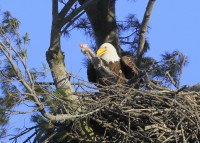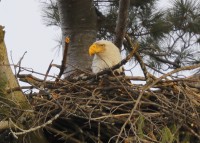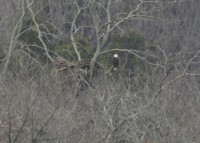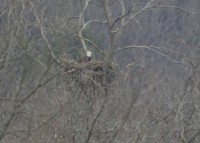Bald Eagle: female on nest
April 3, 2017 in Bald Eagle
April 3, 2017 in Bald Eagle
March 23, 2017 in Bald Eagle
 Sixty to ninety percent of a bald eagle’s diet consists of fish. The birds generally scavenge dead fish, although they will catch live fish as well. The bald eagle is an opportunist and will sometimes steal fish from an osprey or crow. But ospreys have been observed stealing fish from young eagles as well. The bald eagle uses several fishing techniques. A favorite method is to perch in a tree and watch for a fish swimming in open water nearby, and then swoop down to capture it. If a suitable tree is not available near the water for perching, the birds may also fly out over open water looking for fish below. In winter, they may perch on the edge of ice near open water and wait for fish to float by, or to wash up on the ice. After catching a fish the eagle fly back to a perching tree to eat it, bring it back to the nest, or if the fish is small enough, swallow the fish whole while the bird is in flight. Occasionally, eagles will carry a larger fish they have caught back to the ice or to the shore to be eaten. In over 80% of their feeding, wintering bald eagles along the Merrimack River, feed upon small fish they can eat while flying.
Sixty to ninety percent of a bald eagle’s diet consists of fish. The birds generally scavenge dead fish, although they will catch live fish as well. The bald eagle is an opportunist and will sometimes steal fish from an osprey or crow. But ospreys have been observed stealing fish from young eagles as well. The bald eagle uses several fishing techniques. A favorite method is to perch in a tree and watch for a fish swimming in open water nearby, and then swoop down to capture it. If a suitable tree is not available near the water for perching, the birds may also fly out over open water looking for fish below. In winter, they may perch on the edge of ice near open water and wait for fish to float by, or to wash up on the ice. After catching a fish the eagle fly back to a perching tree to eat it, bring it back to the nest, or if the fish is small enough, swallow the fish whole while the bird is in flight. Occasionally, eagles will carry a larger fish they have caught back to the ice or to the shore to be eaten. In over 80% of their feeding, wintering bald eagles along the Merrimack River, feed upon small fish they can eat while flying.
March 13, 2017 in Bald Eagle
 For Bald Eagles, eggs must be kept warm, shaded from harsh sunlight, and protected from predators. In addition to incubating, the eagles also need to turn the eggs about once an hour to ensure that the eggs are evenly heated and that the embryos don’t stick to the insides of the shells. When turning the eggs, the eagles often balled up their talons to prevent their sharp claws from puncturing the eggs. The eggs are rolled over by either parent about every hour to 2 hours during the incubation period. The purpose of this roll is to make sure that the lighter yolk does not rise to the egg surface and the delicate blood vessels that cover the yolk touch and stick to the shell surface, killing the developing chick.The brood patch is an area of bare skin on the bird’s breast that is formed when the bird removes its own feathers. By removing the feathers the parent bird allows his/her body heat to better reach the eggs and keep them at the proper temperature.
For Bald Eagles, eggs must be kept warm, shaded from harsh sunlight, and protected from predators. In addition to incubating, the eagles also need to turn the eggs about once an hour to ensure that the eggs are evenly heated and that the embryos don’t stick to the insides of the shells. When turning the eggs, the eagles often balled up their talons to prevent their sharp claws from puncturing the eggs. The eggs are rolled over by either parent about every hour to 2 hours during the incubation period. The purpose of this roll is to make sure that the lighter yolk does not rise to the egg surface and the delicate blood vessels that cover the yolk touch and stick to the shell surface, killing the developing chick.The brood patch is an area of bare skin on the bird’s breast that is formed when the bird removes its own feathers. By removing the feathers the parent bird allows his/her body heat to better reach the eggs and keep them at the proper temperature.
The female was observed late afternoon rising above the level of the nest while she was doing her egg turning thing, providing nice looks!
March 8, 2017 in Bald Eagle
 Not sure if the female is hunkered down deep in the nest with the male perched next to the nest. Sure looks like they are ready to lay eggs and begin the incubation process!
Not sure if the female is hunkered down deep in the nest with the male perched next to the nest. Sure looks like they are ready to lay eggs and begin the incubation process!
This Bald Eagle nest, like most others, is constructed from large sticks, which are laid together to form the outside part of the nest. The center of the nest is filled with dead weeds, stubble and other softer materials, which may be available in the area. The nest cavity where the eggs are laid is lined with grass, dry moss and feathers. Many Eagle experts believe that some bald eagles show such a strong attraction to their nesting site that, if displaced or overly disturbed, a pair may not return to the nest the following year. This fact places great importance on protecting nesting areas from disturbances such as land development and recreational activities.
March 7, 2017 in Bald Eagle
 This new Bald Eagle nest may well be used for the first time in 2017. The nest was completed in the fall of 2015 and the Eagle pair spent a great deal of time around the nest in the spring of 2016. But it appears that no eggs were ever laid. This “playing house” is not unusual among a newly formed pair of Eagles.
This new Bald Eagle nest may well be used for the first time in 2017. The nest was completed in the fall of 2015 and the Eagle pair spent a great deal of time around the nest in the spring of 2016. But it appears that no eggs were ever laid. This “playing house” is not unusual among a newly formed pair of Eagles.
It has been stated for many years that a Bald Eagle pair will mate for life, but if one partner dies, or disappears, the other will if lucky find another mate. A newly bonded pair may work several years on a nest before actually breeding. They may desert one nest site and start again somewhere else, usually within 1/2 mile. In Eastern Massachusetts, bald eagles will begin to nest sometime in February or March. Each nesting pair will spend a great amount of time preparing the nest before any egg is laid. The successful nest is generally located in a large tree, within one mile from water, either a lake or river, where adequate food is available.
Bald eagle nests are generally found from (50 to 120 feet) above the ground, in a tall, sturdy tree. It takes at least two weeks for a pair of eagles to build their nest.
A typical bald eagle nest will range from 6-10 feet in diameter and about 6 to 10 feet high. The nest cavity, where the eggs are laid, will be about 12 to 16 inches in diameter and about 4 inches deep.
A pair of eagles, once established, may use the same nest several times over a period of years. Each year more materials are added to the nest, which increases the size of the nest each year that it is used. Nests weighing up to 2 tons have been found. Stay tuned!
March 6, 2016 in Bald Eagle
March 2, 2016 in Bald Eagle
May 31, 2014 in Bald Eagle